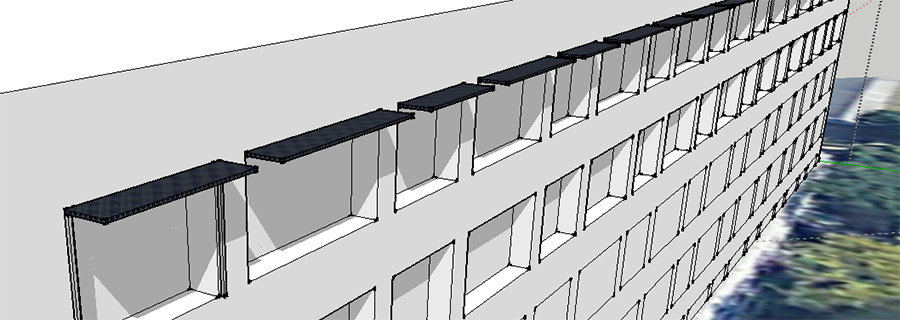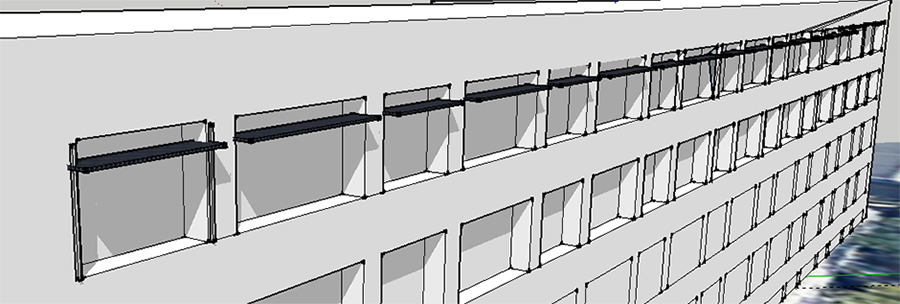Photovoltaic brise soleil
Brise soleil are a relatively common installation solutions for building window facing directly sunward. A bris soleil is normally directly above a window opening and protrude out a certain distance. This distance prevents higher summer sunshine directly hitting the window, causing over heating, but allows the lower winter sunlight through into the window.
Photovoltaic brise soleil work on the same principle, but because the shade is made of a photovoltaic panel, the higher summer sun generates electricity as it deflects the sunshine from the window. These kinds of brise soleil are less common but offer the same external shading which can be fitted over the entire exterior of a building or solely over the problematic window, whilst also contributing to renewable electricity generation electrical power. The types of panels used can vary significantly from solid panels, to individual cells on glass or translucent cells.
Key aspects in the design of photovoltaic brise soleil are consideration of the orientation, overshadowing and safety in maintenance. The southern sides of buildings typically require horizontal brise soleil above the window opening to block the high summer sun.
It is also possible to consider a light shelf type of installation which is installed part way down a window, normally at the transom, where there is a low level large glazed unit and a higher level strip opening unit. This kind of installation blocks some sun to the main glazed ares in summer, particularly at desk level, but it is traditionally also light on its upper surface to reflect light onto the ceiling of the inside space. In teh case of a PV brise soleil, the internal edge may be reflective, but the body of the shade will be darker PV though glossy with some reflectional capabilities.
For the east and west facing sides of a building vertical shading elements might be introduced, though these need to be modelled both in terms of shading ability and electrical production. be used, to follow the sun and actively control the solar gain of the building. This allows optimum protection at the appropriate time of day and year.
[edit] Related articles on Designing Buildings
- Albedo.
- Approved Document O.
- Better prediction of overheating in new homes.
- Comfort in low energy buildings.
- Design summer year (DSY)
- Evolving opportunities for providing thermal comfort.
- Future climate models.
- Good homes alliance overheating tool
- Heat stress.
- Heatwave.
- Human comfort in buildings.
- Low-e glass.
- Maximum and minimum workplace temperatures.
- Natural light.
- Overheating - assessment protocol.
- Overheating in buildings.
- Overheating in residential properties.
- Passive building design.
- Photovoltaics.
- Preventing overheating.
- Retrofitting solar shading.
- Solar gain.
- Solar shading.
- Solar shading of buildings BR 364.
- Solar thermal panels.
- Temperature.
- Thermal comfort.
- Thermal indices.
- Thermal pleasure in the built environment.
- Trombe wall.
- Urban heat island effect.
- Urban heat island.
Featured articles and news
CIOB report; a blueprint for SDGs and the built environment
Pairing the Sustainable Development Goals with projects.
Latest Build UK Building Safety Regime explainer published
Key elements in one short, now updated document.
UKGBC launch the UK Climate Resilience Roadmap
First guidance of its kind on direct climate impacts for the built environment and how it can adapt.
CLC Health, Safety and Wellbeing Strategy 2025
Launched by the Minister for Industry to look at fatalities on site, improving mental health and other issues.
One of the most impressive Victorian architects. Book review.
Common Assessment Standard now with building safety
New CAS update now includes mandatory building safety questions.
RTPI leader to become new CIOB Chief Executive Officer
Dr Victoria Hills MRTPI, FICE to take over after Caroline Gumble’s departure.
Social and affordable housing, a long term plan for delivery
The “Delivering a Decade of Renewal for Social and Affordable Housing” strategy sets out future path.
A change to adoptive architecture
Effects of global weather warming on architectural detailing, material choice and human interaction.
The proposed publicly owned and backed subsidiary of Homes England, to facilitate new homes.
How big is the problem and what can we do to mitigate the effects?
Overheating guidance and tools for building designers
A number of cool guides to help with the heat.
The UK's Modern Industrial Strategy: A 10 year plan
Previous consultation criticism, current key elements and general support with some persisting reservations.
Building Safety Regulator reforms
New roles, new staff and a new fast track service pave the way for a single construction regulator.
Architectural Technologist CPDs and Communications
CIAT CPD… and how you can do it!
Cooling centres and cool spaces
Managing extreme heat in cities by directing the public to places for heat stress relief and water sources.
Winter gardens: A brief history and warm variations
Extending the season with glass in different forms and terms.
Restoring Great Yarmouth's Winter Gardens
Transforming one of the least sustainable constructions imaginable.


























